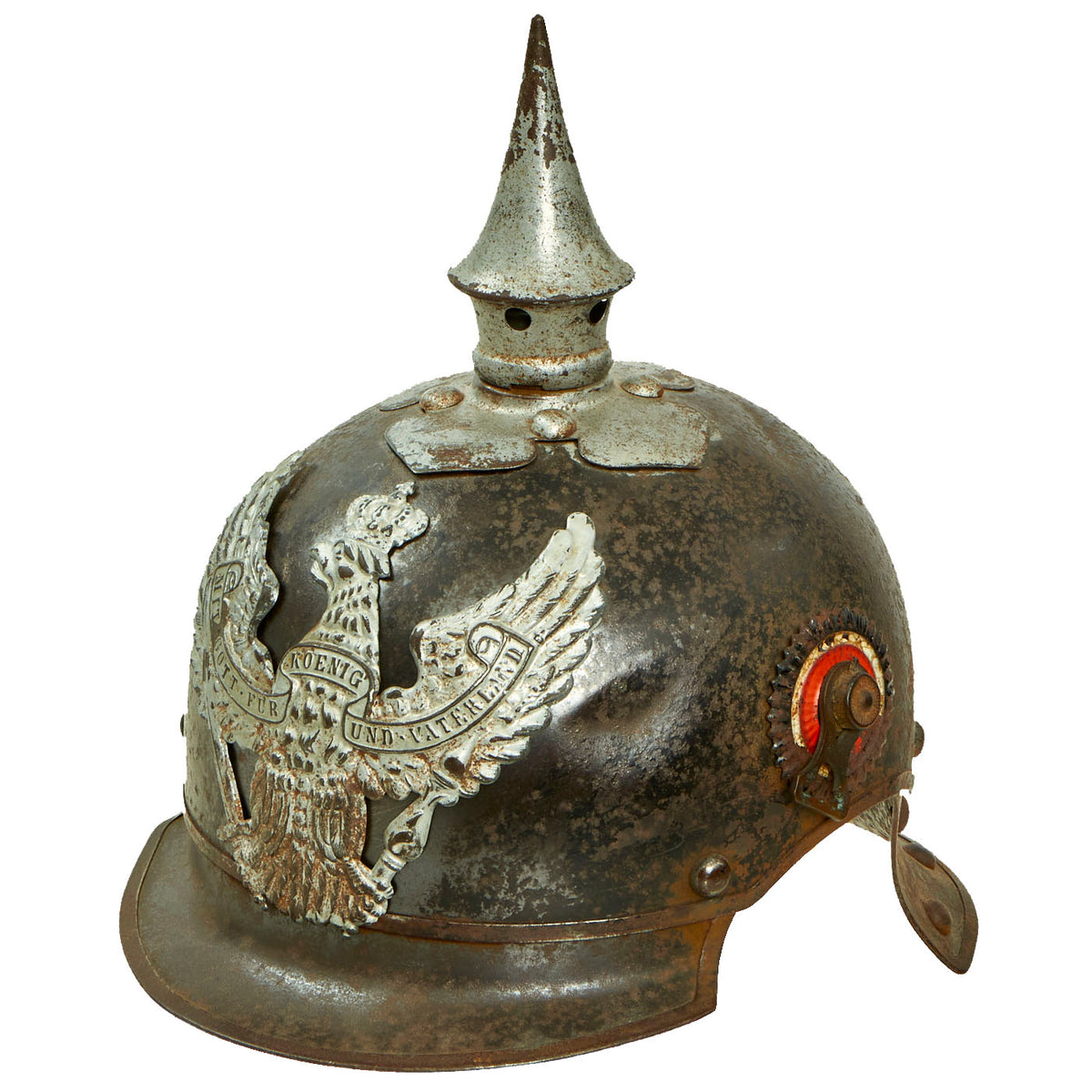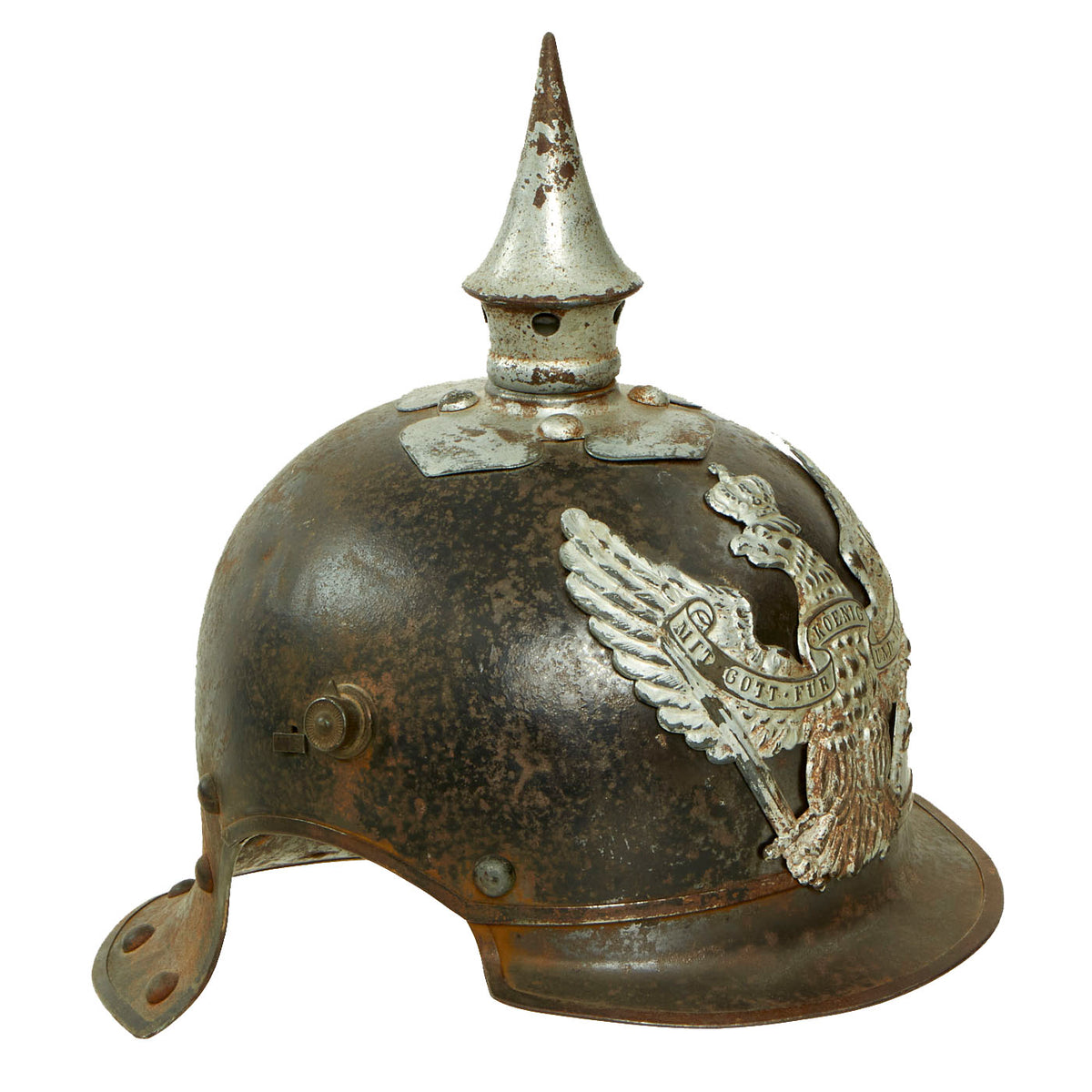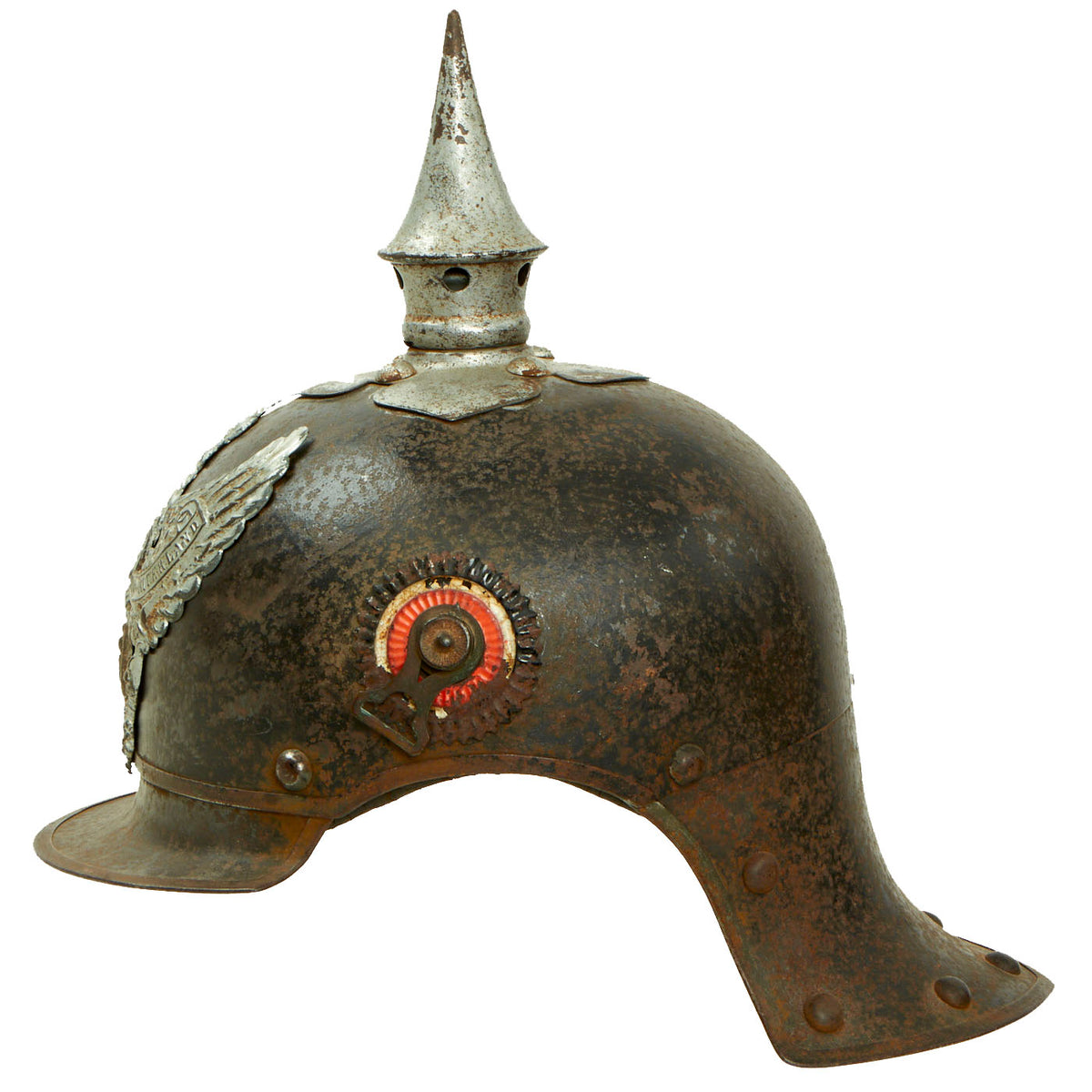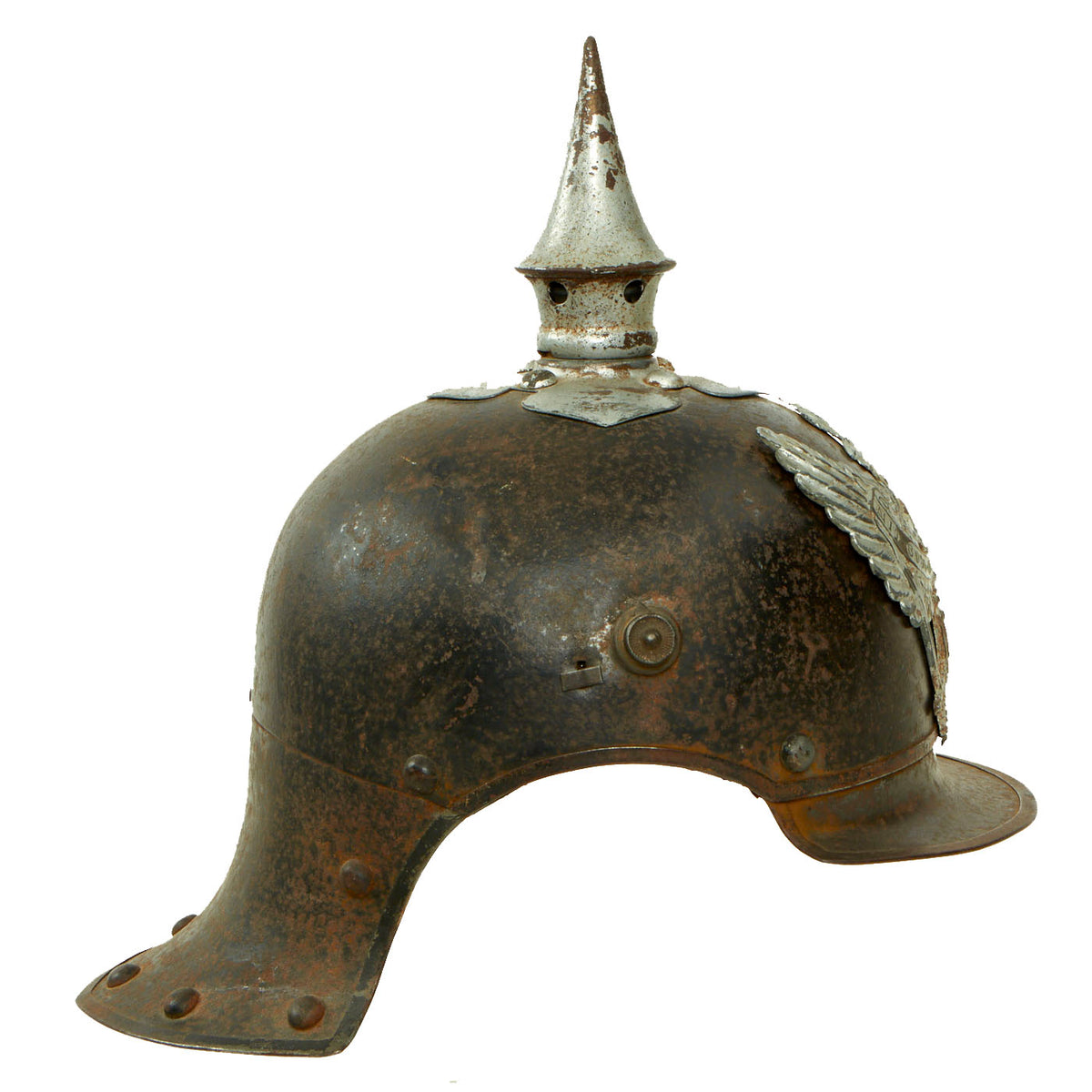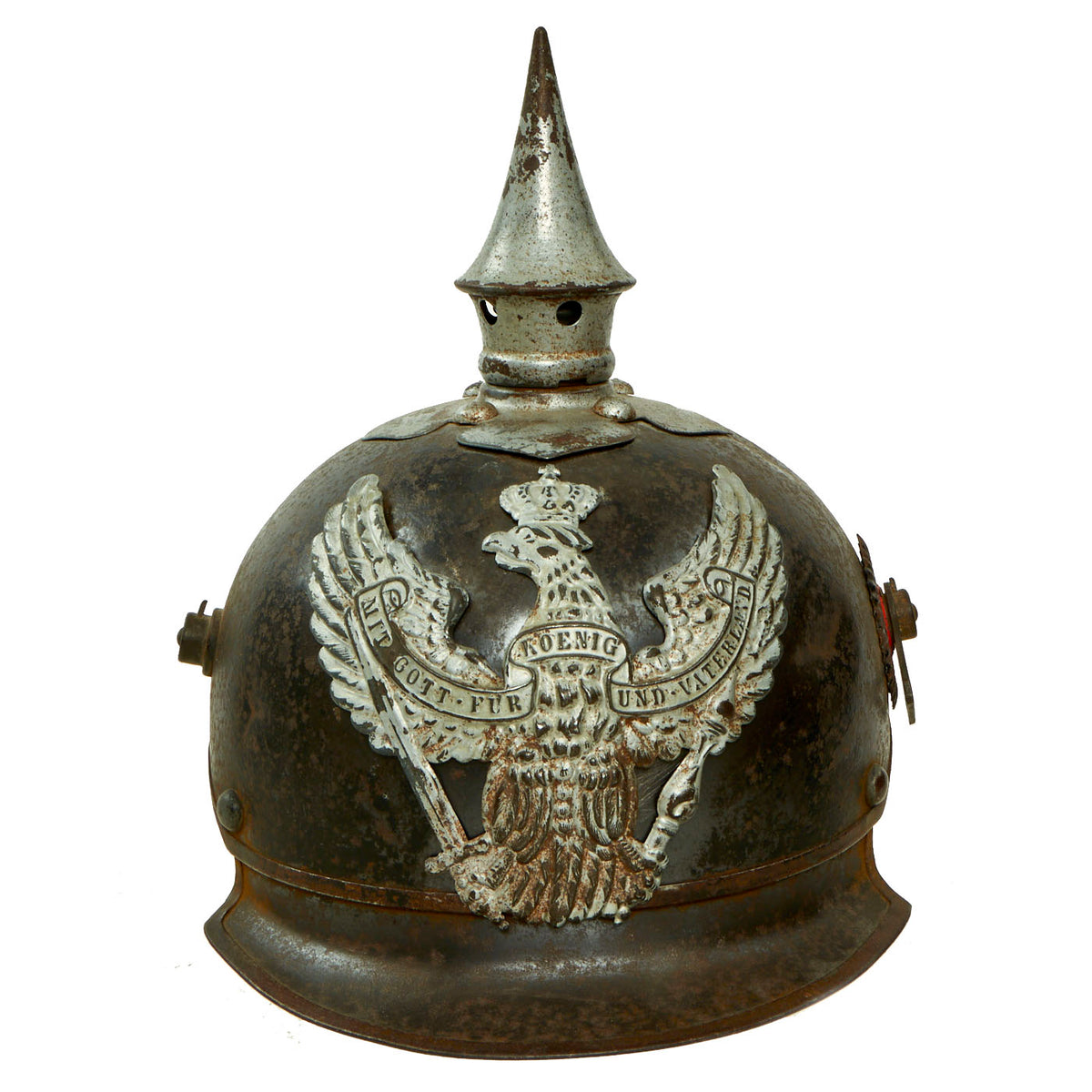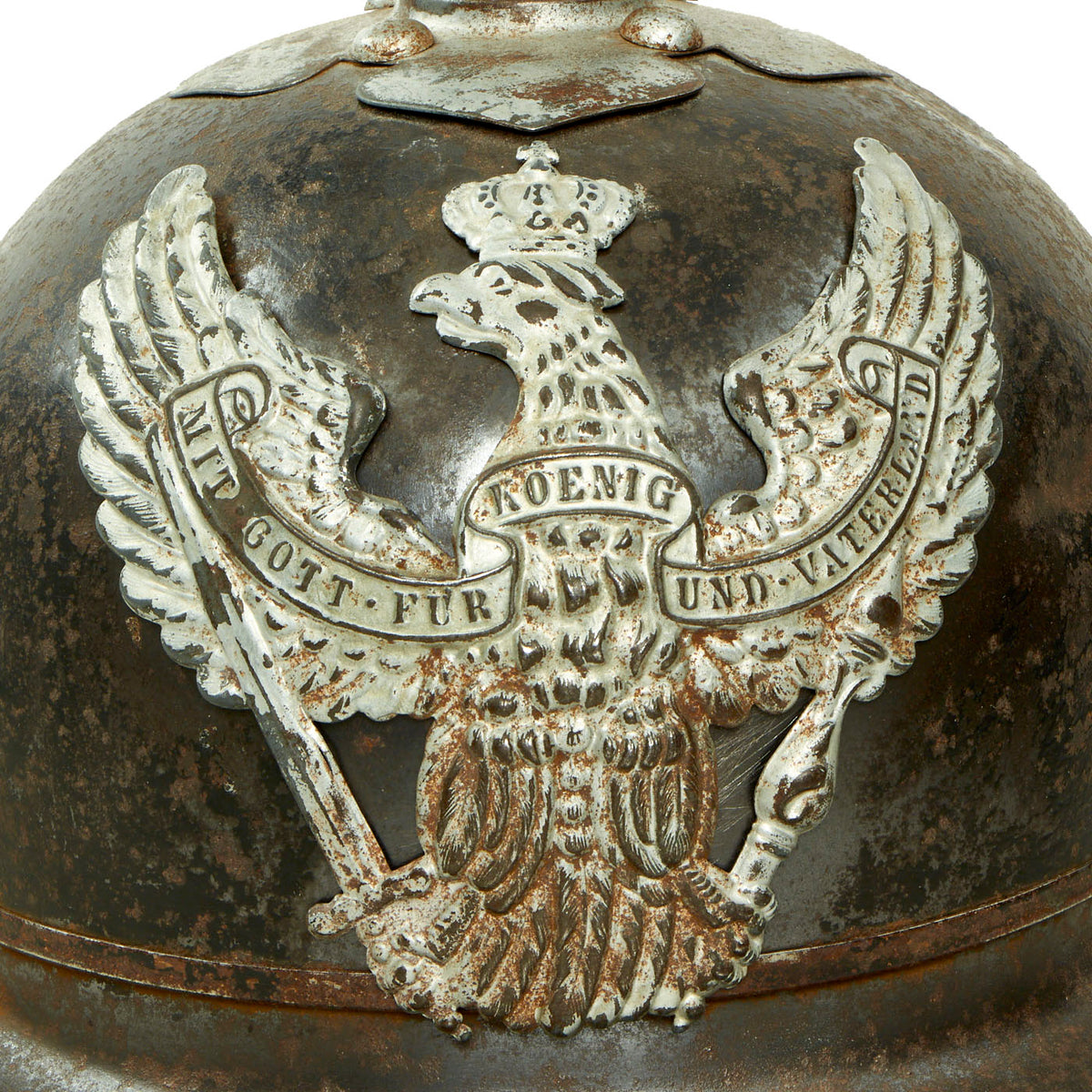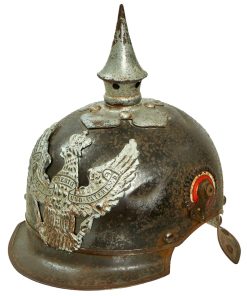Original German WWI Prussian M1915 Jäger zu Pferde Lobster Tail Pickelhaube Helmet by Herman Weissenburger & Cie Cannstatt Original Items
$ 1.095,00 $ 273,75
Original Item: Only One Available. This is a decent condition Imperial German Prussian M1915 Jäger zu Pferde (Mounted Dispatch Rider) Lobster Tail Pickelhaube Helmet, made by Helbing & Sackewitz. This is one of the two varieties of Metalhelme (Metal Helmets) in use by the German Armed forces, the other of which are the Kürassier Metalhelme worn by heavy cavalry.
The M1915 was the last model of Pickelhaube issued. In accordance with the 1915 regulations these helmets would no longer use brass, silver, or Tombak as previous models did. All issued Pickelhaube would now use gray oxidized steel fittings for all Regiments, where previously the dispatch rider fittings had varied based on the regiment. Also, this last revision of the Dispatch Rider helmet replaced the usual chin scale chin strap with the standard M91 leather chin strap, and it would now have the standard removable spike, held on with a “bayonet” style attachment.
This pickelhaube has a basic three-piece construction: helmet, visor and extended rear protective neck guard. It is fabricated from blackened stamped manganese steel, which is the distinctive black mounted dispatch rider finish. The helmet is topped by a removable spike with four ventilation holes and a spike mounting base in the distinctive “cloverleaf” shape used by the dispatch riders, which is held in place by four large capped rivets. The front comes with a visor designed with a turned-up lip, held in place by large capped rivets on either end.
This helmet features a steel pattern steel frontplate (wappen). The rear neck guard protrudes outwards, away from the body in the traditional “lobster tail” design, held in place with large capped rivets just inside the outer edge and one smaller central rivet at the rear neck line. The entire outer edge is trimmed in a rolled-around steel band, including the visor and neck guard, protecting the wearer from the raw steel edges of the helmet itself. It is size stamped 56 on the steel rim on the underside of the neck guard, along with being maker stamped and dated HELBING u. / SACKEWITZ / 1916 on the inside of the dome, around the vent hole.
The front Dragoon-style wappen features the Prussian state eagle clutching a sword and rod, over the King’s motto, MIT GOTT FÜR KOENIG UND VATERLAND (With God for King and Country, i.e. Prussia). The plate and spike appear to have been painted with silver paint a very long time ago.
Only National kokarden (cockade) is present. In 1897 the new Reichs-Kokarde in Red-White-Black was introduced for all ranks to commemorate the 100th anniversary of the birth of Kaiser Wilhelm 1st. The Reichs-Kokarde was to be worn on the right side of the helmet, and the Black & White Prussian state Kokarde was moved to the left. The cockade is still secured by the original chinstrap hardware.
The interior leather liner is unfortunately almost completely missing, which is how these helmets are often found, as the leather is far less resilient than the steel, so when brought back from the war, the usually rotted liner was removed and discarded.
Condition overall is good, with a lot of the original finish present, though there is oxidation in areas, as pictured.
Overall a nice condition Imperial German Prussian Jäger zu Pferde Lobster Tail pickelhaube with a maker marking and date, perfect for any WWI collection!
Jäger zu Pferde (Hunter on Horseback)
The hunters on horseback were a type of light cavalry that was mainly used for reconnaissance and security tasks. Similar to the hussars , the hunters on horseback served primarily for reconnaissance and security tasks, but were also increasingly used as battle cavalry. Napoleon I’s Mounted Guard Chasseurs also served as staff cavalry (as messenger riders, covering headquarters and the Emperor’s personal escort). The hunters on horseback made their appearance in the mid to late 18th century when the need for regular light cavalry was recognized but the expense of raising elaborately uniformed hussar units was avoided.
Forerunners were some Freikorps in France , for example the Fischerschen Jäger set up in 1743. In 1779, six Jäger regiments of line cavalry were set up there for the first time, other states such as Russia (1790–1882, finally 19 regiments ), Austria (one regiment, 1798–1801), Italy (four regiments, 1805–1814) and the USA (a regiment 1846–61) followed. In Napoleonic France , the branch of arms grew to 31 line and 2 guard regiments, after the restoration remained 24 of the line and one of the guard, including four in Algeria in 1831 Raised regiments Chasseurs d’Afrique came, which were soon considered the best cavalry troop in the French army . In Belgium, the three regiments set up in 1830/31 were disbanded in 1994 and 2004 respectively.
It was not until 1901 that the first regiment (Königs-Jäger zu Pferde No. 1) was set up in the Prussian army. This was followed by 1905 Nos. 2 and 3 , 1906 No. 4 , 1908 No. 5 and 1910 No. 6 . In 1913 the 7th, 8th, 9th, 10th, 11th, 12th and 13th regiments were formed.
In the trench warfare of the First World War , cavalry generally lost its importance and was mostly used as infantry . In the Reichswehr , there was no longer a distinction made according to individual troop categories such as hussars, dragoons, cuirassiers or chasseurs on horseback. The tradition of the regiments of the Old Army was not transferred according to troop category, but to the cavalry regiments of the Reichswehr and became a blurred formation of the Wehrmacht in 1935.
In France, the term “chasseurs à cheval” stuck for a long time, although over time the regiments became mechanized infantry, armored scouts or armored troops. It was only towards the end of the 20th century that the addition “à Cheval” was dropped, although the remaining regiments 1er régiment de chasseurs , 4 e régiment de chasseurs and 1er régiment de chasseurs d’Afrique continued their cavalry tradition.
The uniform was often based on that of the hussars, but was usually less elaborate and mostly green. In France it was bottle green with collar and lapels in insignia color, the initially worn tarleton – style caterpillar helmet giving way during the revolution to wing caps and finally to shako or (in the case of the elite companies and the Old Guard) kolpak. In Austria a gray uniform in the Chevauleger style was worn, in Russia a green dragoon uniform, but with chakkos instead of helmets. The Chasseurs d’Afrique received light blue skirts. In 1873 the French line regiments also received theAttila light blue.
Since in the German Reich the reporting rider detachments, from which the first regiments emerged, were initially assigned to the Guards, their uniform, despite their role as light cavalry, was initially based on that of the heavy Guards cavalry (i.e. collars and metal cuirassier spiked helmet with a deep neck guard) . , but was gray-green for all types of suits from the start. In 1910 the collars for the existing regiments were abolished and replaced by tunics. A gray-green uniform based on the Dragoon pattern was issued for the 8th to 13th regiments, which were raised in 1913. However, the officers of these new regiments wore the cuirassier helmet.
The armament consisted of a sword or sword and the carbine. In Prussia, the hunters on horseback, like the entire cavalry, also wielded lances.
Fast Shipping with Professional Packaging
Thanks to our longstanding association with UPS FedEx DHL, and other major international carriers, we are able to provide a range of shipping options. Our warehouse staff is expertly trained and will wrap your products according to our exact and precise specifications. Prior to shipping, your goods will be thoroughly examined and securely secured. We ship to thousands clients each day across multiple countries. This shows how we're dedicated to be the largest retailer on the internet. Warehouses and distribution centres can be located throughout Europe as well as the USA.
Note: Orders with more than one item will be assigned a processing date depending on the item.
Before shipping before shipping, we'll conduct a thorough inspection of the items you have ordered. Today, the majority of orders will be delivered within 48 hours. The delivery time will be between 3-7 days.
Returns
The stock is dynamic and we cannot completely manage it because multiple stakeholders are involved, including our factory and warehouse. So the actual stock may alter at any time. It's possible that you may not receive your order once the order has been made.
Our policy is valid for a period of 30 days. If you don't receive the product within 30 days, we are not able to issue a refund or an exchange.
You can only return an item if it is unused and in the same state as the day you received it. You must have the item in its original packaging.
Related products
Uncategorized
Uncategorized
Uncategorized
Uncategorized
Uncategorized
Uncategorized
Band of Brothers ORIGINAL GERMAN WWII Le. F.H. 18 10.5cm ARTILLERY PIECE Original Items
Uncategorized
Uncategorized
Uncategorized
Armored Burgonet Helmet & Polearm from Scottish Castle Leith Hall Circa 1700 Original Items
Uncategorized
Uncategorized
Uncategorized
Uncategorized
Uncategorized
Angolan Rebel 1970s era 60mm Inert Display Mortar from Angolan Civil War Original Items
Uncategorized
Armoured Fighting Vehicles of the World: AFVs of World War One (Hardcover Book) New Made Items
Uncategorized
Uncategorized
